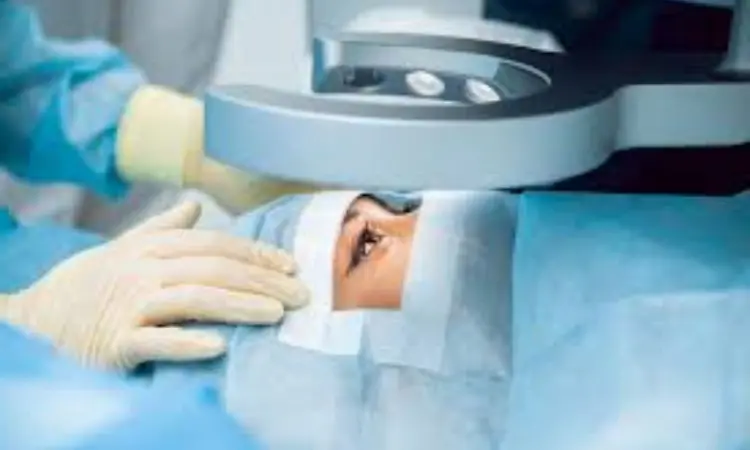- Home
- Medical news & Guidelines
- Anesthesiology
- Cardiology and CTVS
- Critical Care
- Dentistry
- Dermatology
- Diabetes and Endocrinology
- ENT
- Gastroenterology
- Medicine
- Nephrology
- Neurology
- Obstretics-Gynaecology
- Oncology
- Ophthalmology
- Orthopaedics
- Pediatrics-Neonatology
- Psychiatry
- Pulmonology
- Radiology
- Surgery
- Urology
- Laboratory Medicine
- Diet
- Nursing
- Paramedical
- Physiotherapy
- Health news
- Fact Check
- Bone Health Fact Check
- Brain Health Fact Check
- Cancer Related Fact Check
- Child Care Fact Check
- Dental and oral health fact check
- Diabetes and metabolic health fact check
- Diet and Nutrition Fact Check
- Eye and ENT Care Fact Check
- Fitness fact check
- Gut health fact check
- Heart health fact check
- Kidney health fact check
- Medical education fact check
- Men's health fact check
- Respiratory fact check
- Skin and hair care fact check
- Vaccine and Immunization fact check
- Women's health fact check
- AYUSH
- State News
- Andaman and Nicobar Islands
- Andhra Pradesh
- Arunachal Pradesh
- Assam
- Bihar
- Chandigarh
- Chattisgarh
- Dadra and Nagar Haveli
- Daman and Diu
- Delhi
- Goa
- Gujarat
- Haryana
- Himachal Pradesh
- Jammu & Kashmir
- Jharkhand
- Karnataka
- Kerala
- Ladakh
- Lakshadweep
- Madhya Pradesh
- Maharashtra
- Manipur
- Meghalaya
- Mizoram
- Nagaland
- Odisha
- Puducherry
- Punjab
- Rajasthan
- Sikkim
- Tamil Nadu
- Telangana
- Tripura
- Uttar Pradesh
- Uttrakhand
- West Bengal
- Medical Education
- Industry
Does immediately sequential bilateral cataract surgery control endophthalmitis better?

Cataract Surgery
Seattle, Washington: A recent study showed that there was no statistically significant difference in the risk of postoperative endophthalmitis between individuals who had immediately sequential bilateral cataract surgery (ISBCS), delayed sequential bilateral cataract surgery (DSBCS), or unilateral cataract surgery. The findings of this study were published in the journal Ophthalmology.
Using the American Academy of Ophthalmology Intelligent Research in Sight (IRIS) Registry database, Megan Lacy and the team compared the risk of postoperative endophthalmitis following ISBCS and DSBCS.
This was a retrospective cohort study where patients from the IRIS Registry who had cataract surgery between 2013 and 2018 were chosen. Patients who had cataract surgery were split into two groups: (1) ISBCS and (2) DSBCS (second-eye surgery one day after first-eye surgery) or unilateral surgery. By the International Classification of Diseases (ICD) code and ICD code with additional clinical criteria, postoperative endophthalmitis was classified as endophthalmitis occurring within 4 weeks following surgery. The main outcome assessed in this study was the Rate of postoperative endophthalmitis.
The key findings of this study were as follow:
1. Of the 5 573 639 IRIS Registry patients who had cataracts removed, 165 609 had ISBCS and 5 408 030 had DSBCS or unilateral surgery.
2. A total of 3102 people (0.056%) satisfied the study's postoperative endophthalmitis criteria, with supportive clinical results.
3. The two surgical groups had identical incidences of endophthalmitis in either surgery eye. Although the ISBCS group had a slightly greater rate of endophthalmitis than the DSBCS or unilateral groups, after correcting for age, sex, race, insurance status, and concomitant ocular condition, the odds ratio did not achieve statistical significance.
4. In the DSBCS group, there were seven occurrences of bilateral endophthalmitis with supportive clinical evidence, but none in the ISBCS group.
In conclusion, given the low and equivocal incidence of postoperative endophthalmitis associated with both techniques, patients may have more options when deciding between ISBCS and DSBCS.
Reference:
Megan Lacy, Timothy-Paul H. Kung, Julia P. Owen, Ryan T. Yanagihara, Marian Blazes, Suzann Pershing, Leslie G. Hyman, Russell N. Van Gelder, Aaron Y. Lee, Cecilia S. Lee, Flora Lum, Emily Chew, Julia A. Haller, Alice C. Lorch, Joan W. Miller, Endophthalmitis Rate in Immediately Sequential versus Delayed Sequential Bilateral Cataract Surgery within the Intelligent Research in Sight (IRIS®) Registry Data, Ophthalmology, 2022, https://doi.org/10.1016/j.ophtha.2021.07.008.
Medical Dialogues consists of a team of passionate medical/scientific writers, led by doctors and healthcare researchers. Our team efforts to bring you updated and timely news about the important happenings of the medical and healthcare sector. Our editorial team can be reached at editorial@medicaldialogues.in.
Dr Kamal Kant Kohli-MBBS, DTCD- a chest specialist with more than 30 years of practice and a flair for writing clinical articles, Dr Kamal Kant Kohli joined Medical Dialogues as a Chief Editor of Medical News. Besides writing articles, as an editor, he proofreads and verifies all the medical content published on Medical Dialogues including those coming from journals, studies,medical conferences,guidelines etc. Email: drkohli@medicaldialogues.in. Contact no. 011-43720751


